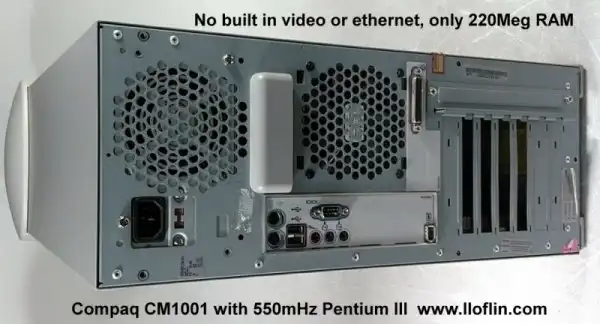
Fig. 1 Compaq Presario CM1001 Series computer circa 1999.
Presario 1999 CM1001 Gaming Computer Salvage
View all of my You Tube Videos
Also visit and subscribe to My YouTube Channel
The purpose here is to review older computer hardware. This is also an introduction to some computer hardware.
In my video above I review the reuse of a Presario CM1001 series computer. Manufactured in 1999 it was at a crossroads for PC hardware.
Today what cost perhaps $2000+ in 1999 sells on Ebay for $140 plus shipping.
And shipping cost are high. The one I have weighs 20-30 pounds. The basic computer has no built in video or ethernet.
This is what I call intermediary technology. Some peripherals were integrated onto the motherboard. This includes sound, 2 X IDE ports, parallel port, Firewire, serial port, game port, 4 USB 1.1 ports.
No ethernet or video. It had a Pentium III 550Mhz processor an expensive item at the time. To quote CNN Money August 23, 1999:
"Intel dropped the price of the 550-MHz Pentium III to $487 from $658, a 26-percent cut in 1,000-unit quantities."
That gives one in 2021 a clue just how expensive computer hardware was in 1999. Adjusted for inflation $487 is $770 in 2020!
I'll review basic motherboard hardware as we go along.
The one I have was given to me by a friend. It was in pristine condition. One of the 2 CD ROM readers was bad.
It has an old 120 Meg ZIP drive that I have no tape cartridges for.
I removed two old dial up modem cards.
This is what I did to make it more usable. It did boot up with Windows 98 and 220 megabytes of memory. I upgraded that to 384 megabytes, installed Windows Me.
Fig. 1 view of back end of the case. We have integrated printer port DB25 connector, a single serial port, sound (in, out, mic), PS2 keyboard-mouse ports, and 2 USB 1.1 connectors. The front panel has a game port connector and 2 more USB 1.1.
USB 2.0 wouldn't be released until April 2000 and USB 3.0 would be released November 2008.
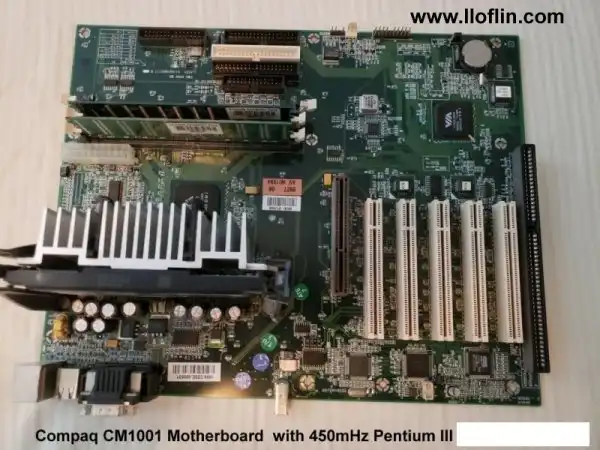
Fig. 2 Compaq Presario CM1001 Series computer motherboard.
Fig. 2 is the motherboard. It comes with 5 PCI slots (white), one accelerated graphics port (AGP) connector (brown), and a single industry standard architecture (ISA) slot.
Mine came with 2 modems I removed and an ISA ethernet card my Linux ignored. I had to install a more recent PCI buss card.
Also included was obsolete Firewire connectors, 1 floppy drive connector, and 2 IDE (parallel ATA) connectors for hard drives and CDROMs.
Modern computers use none of these. IDE has been replaced by serial ATA (SATA) connectors.
PCI stands for Peripheral Component Interconnect. PCI 1.0 was introduced in 1992. The last upgrade to PCI 3.0 was 2004. They have been replaced by PCI Express.
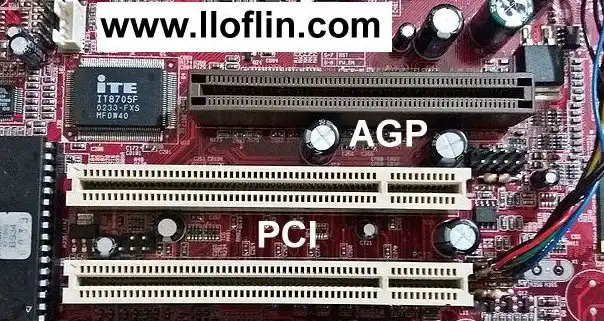
Fig. 3 AGP graphics port and 2 PCI connectors.
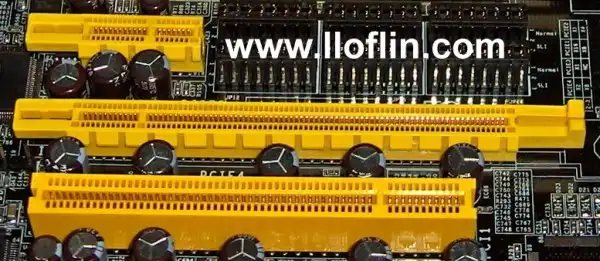
Fig. 4 Example PCI Express and a PCI slots.
To quote Wiki:
PCI Express (Peripheral Component Interconnect Express), officially abbreviated as PCIe or PCI-e, is a high-speed serial computer expansion bus standard, designed to replace the older PCI, PCI-X and AGP bus standards. It is the common motherboard interface for personal computers' graphics cards, hard disk drive host adapters, SSDs, Wi-Fi and Ethernet hardware connections...
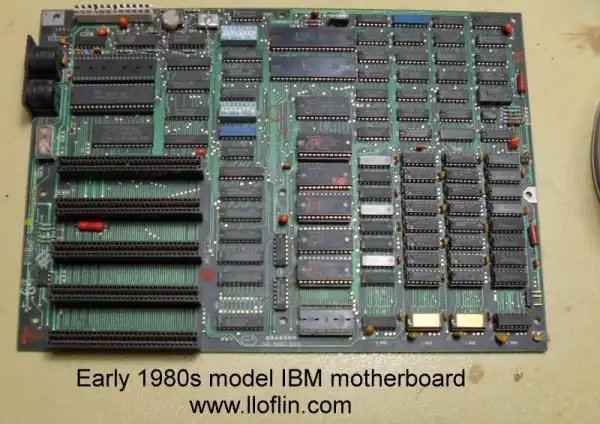
Fig, 5 Early 1980s IBM motherboard with 8-bit ISA slots.
To quote Wiki:
Industry Standard Architecture (ISA) is the 16-bit internal bus of IBM PC/AT and similar computers based on the Intel 80286 and its immediate successors during the 1980s. The bus was (largely) backward compatible with the 8-bit bus of the 8088-based IBM PC, including the IBM PC/XT as well as IBM PC compatibles...
The 16-bit ISA bus was also used with 32-bit processors for several years. An attempt to extend it to 32 bits, called Extended Industry Standard Architecture (EISA), was not very successful, however. Later buses such as VESA Local Bus and PCI were used instead, often along with ISA slots on the same mainboard...
My first motherboard I bought in the 1980s was an IBM board with 128? megabytes of onboard memory and cassette basic on ROM. It used a 4.7mHz processor.
It used 8-bit ISA slots and had no onboard anything not even a real time clock. Everything as I remember was on plug cards.
Today I have no keyboard or power supply for this board.
My Presario had a single 16-bit ISA slot. ISA was on the way out by 1999.
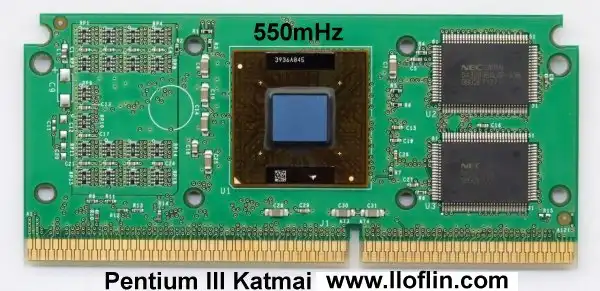
Pentium III Katmai CPU.
The Pentium III Katmai CPU is more a large module. It was also expensive.
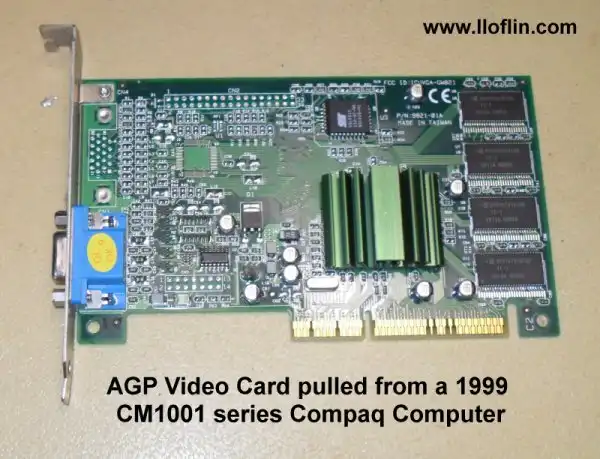
AGP video card from Presario CM1001 computer.
The computer came with the above S3 video card. This worked fine with Tinycore and Debian 7 Linux.
Windows Me was a fit. No Windows driver could be found based on the Compaq part or model number.
I searched Ebay until I found the card and the seller identified the card.
The card turned out to be a S3 Savage 4 AGP 8MB 3D Gaming Video Graphics Card. I located the S3 drivers.
The video card did a great job on retro games. In its time it was also expensive.
Most modern mother boards have built in video. A separate video card will over ride the built in video.
The AGP slot was abandoned after ~2000.
Software
Why use Window Me? It was the latest version of Windows that would work. Like Win98 required no activation.
Windows WinXP will no longer activate. And Win98 drivers worked with Me. It recognized the rest of the hardware including the ISA ethernet card.
My Linux versions needed a PCI slot ethernet card.
Because I had a lot of older parts I had zero cost to upgrade. I also had a lot of DOS and Win98 software. It ran fine on Tinycore Linux as well.
But the reality it's a museum piece and retro gaming machine. Yes I like my Wolfenstein and DOOM video games.
No modern web browser would operate nor modern video player like VLC. The Aurora browser in Tinycore 4.7 worked OK but a little slow.
I still have some electronics prototyping cards for the ISA slots. It will run and compile C/C++ programs on Tinycore Linux and my Borland C++ for DOS.
Back to Upcycle-Reuse older Classic Computer Hardware
- Hobby Electronics Home Page
- Donate
- Exploring Digital Computer Electronics
- Hardware
- Hardware Review Connecting PC Parallel Ports
- Operation TB6600 Stepper Controller with PC Parallel Port
- Build or Buy Parallel Port Breakout Board?
- Build Serial HD44780 LCD Display Connect to Parallel Port
- Motherboards
- Presario 1999 CM1001 Gaming Computer Salvage
- Live Test 2002 VIA EPIA-800 Mini ITX Motherboard
- Salvage, Test 2012 AAEON EMB-B75A Industrial Motherboard
Related programming and hardware:
- Main Light Fast Linux Desktops with Openbox, JWM
- Test Reuse Surplus PC Power Supplies
- Add WBAR Launch Dock to Raspberry Pi
- Add MPG123 Terminal Music Player to Raspberry Pi, Linux
- Basics of Alsamixer Audio Control for Linux
- Add Solid State Hard Drive to Raspberry Pi
- Beep a PC Speaker Add Beeper to Raspberry Pi
- Using FEH Wallpaper Setter Under Linux
- Scrot Lite Weight Screen Shot Software for Linux
- Using Light Weight Beaver Text Editor
- Install Viewnior Image Viewer for Linux
- Zmixer ALSA Sound Control Tutorial
- Tutorial Xinitrc Desktop Manager Control for Linux
- Setup Raspberry Pi Using JWM Window Manager
Linux Videos
Live Linux Distro for Using Printer Port with Electronics
Using the powerful Rox-Filer system in Linux
Use FEH under Linux for a Wallpaper Setter
How to create Symbolic links in Linux
- Off Site:
- Web Master
- Tri-Cities VA-TN
- General Science
- Hobby Electronics
- US Constitution
- Christianity 101
- Religious Themes
Web site Copyright Lewis Loflin, All rights reserved.
If using this material on another site, please provide a link back to my site.